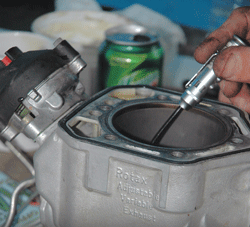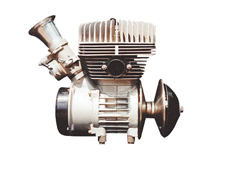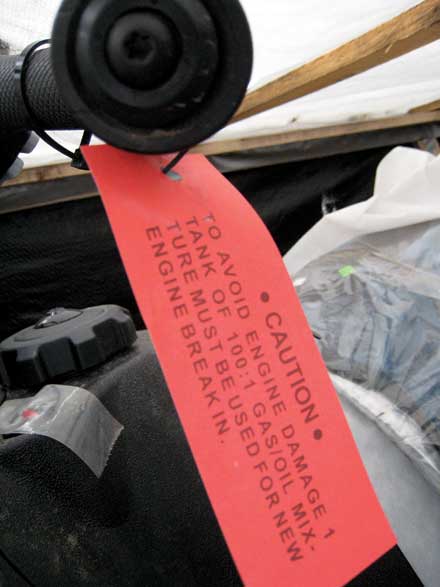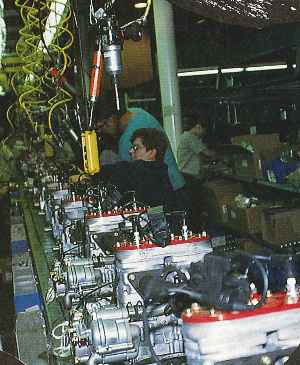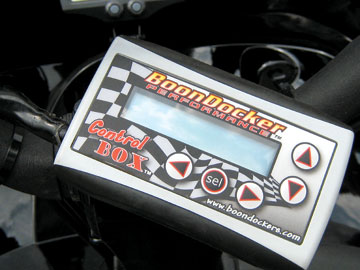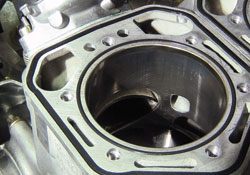Engineious Application
 That is exactly what it did.
That is exactly what it did.
“It was always a conversation-maker at stops,” said Engle of Annandale, Minnesota. “Many people wanted to ride it.”
He didn’t say whether he indulged the curious, but it’s understandable why they would at least ask: the RS Vector turned a new page for Yamaha in four-stroke performance with its new 120 hp Genesis 120 engine.
We surveyed RS Vector and RS Vector ER owners for their opinions of the machine after a season on snow. We asked for ratings on all aspects of performance, including engine, suspensions, handling and ergonomics. (The scale was 1 to 5, with 1 as “poor” and 5 as “excellent.”) We also solicited comments on services performed, hits and misses, and demographics.
The good comments far outweighed the bad, and the overall satisfaction rate was high — 94 percent said the model met their expectations, 89 percent said they’d buy this model again and that it was worth the money.
“This machine is the best of all the machines I have owned. I’ve owned 22 snowmobiles, 18 of them Yamahas ,” said Loren Wetenhall of Flint, Michigan. “
The top two favorite features on the Vector are related: fuel economy and the four-stroke Genesis 120 engine.
“It has a great powerband and almost no vibration,” said Dan DeVas of Prior Lake, Minnesota. “It handles very good and uses less fuel than any of my fellow snowmobilers’ sleds.”
Owners reported fuel economy generally in the 17 to 20 mpg range, but Bob Roberts of Owosso, Michigan, said that his was as high as 24 mpg.
This fuel efficiency comes from the all-new three-cylinder engine. It’s in the same power class as 600cc two-strokes despite its 973cc output. Its top horsepower peak is at 8600 rpm and the peak torque comes at 7000 rpm.
“This convinced me that four-strokes can be competitive with two-strokes,” said an anonymous owner from Illinois.
Perceived reliability seemed to be a big sell for buyers, even for this new-to-the-market engine.
Dave Byer of Waseca, Minnesota, decided on this four-stroke based on the performance of other Yamaha products. “The bike engines run forever,” he said. Side note: The Genesis 120 was purpose-built for snowmobiles, and doesn’t have a motorcycle history.
David Conklin of Kawkawlin, Michigan, said his favorite aspect of the engine was “holding it at 90 mph-plus on railroad grades and not worrying about blowing up.”
The perception of engine reliability seemed to match actual experience. No one reported engine issues as a needed repair.
“Yamaha four-strokes are premium. You just have to ride one to appreciate their quality, durability and performance,” Roberts said.
Overall, owners found the machine to have decent low- and mid-range power. Some were disappointed when the machine reached the top of the powerband, however.
“It had great power all the way to the end, but I wished it had a little more top-end,” said Bob Egan of North Branch, Minnesota.
The four-stroke engine gave two added benefits, which owners appreciated: quiet performance and no need to add oil.
Several owners gave no rating in the “oil consumption” category, citing it was a non-issue due to the four-stroke engine. Oil consumption still got the highest score compared to any other sled feature: it got a 4.9 rating on the 5-point scale.
“It used no motor oil in 3,600 miles,” claimed Yoland Gauvin of Jay, Maine.
“Oil change” was, by far, the most common service item reported — 45 percent of owners said they had this service performed.
The quiet engine was a perk for most owners, though it generated a couple of unexpected complaints. One owner complained about wind noise around his helmet at high speeds; another found the track noise particularly annoying when on hardpack.
We were critical of the suspension package on our staff RS Vector, so we were curious to see if other owners agreed.
They did. General consensus was that as long as trails were generally smooth, the suspension performed fine. Large bumps presented large problems.
The rear suspension quality over big bumps got the second-to-the-lowest rating in the entire survey, a 3.7. Other suspension features to get ratings in the “3” range were the front suspension performance on large bumps (3.8), front shock adjustability (3.8), rear suspension adjustability (3.9) and rear shock adjustability (3.8).
The machine came with the Pro Active rear suspension, which was new on this model. It featured multiple points of adjustment, including a three-position rear spring preload adjuster, a spring bottom stopper and adjustable control rods. The rear suspension offered 11.5 inches of travel and used a KYB aluminum shock in front and a KYB hydraulic shock in back.
“It’s a simple suspension that works well without frequent adjustments,” said Alan Raymond of Holland, New York. “It steers well, tracks straight without double runners [that were] required on previous sleds, especially the SXViper.”
Others had a more difficult time dialing in the suspension.
“I just couldn’t get the rear suspension set up for my weight,” said Conklin, who’s 150 pounds. Gauvin, also 150 pounds, found the ride too stiff.
“The suspension needs some changes to be on par with the engine/clutch package,” said an anonymous Wisconsin owner.
Some owners put Fox FLOAT air shocks and the Mono Shock RA rear suspension on their wish lists for this sled. The Mono Shock RA is standard on the 2006 RS Vector ER and GT models.
There were few direct complaints about the front suspension. The A-arm suspension used aluminum high-pressure gas shocks with 9 inches of travel.
Even with the suspension shortfalls, there were not many quibbles about overall handling. Most negative comments regarded weight transfer and cornering.
“It’s a great machine on the trails and overall was one of the nicest machines I’ve ever had,” Conklin said.
“On perfectly groomed trails, performance and quality are excellent,” said Jeff Sonstegy of Alexandria, Minnesota. “It’s a little heavy in the rough and an easier way to adjust the weight transfer would be nice.”
David Webster of Clarence Center, New York, felt his 2002 Yamaha SXViper cornered better than his vector.
“If it cornered better and had more storage, it would be almost perfect,” said an anonymous Michigan owner.
The topic of weight came up repeatedly.
The RS Vector cut weight in a lot of areas from its meaty RX-1 sibling. The Genesis 120 is a claimed 22 pounds lighter than the RX-1’s Genesis Extreme engine. The RS Vector’s claimed dry weight is 536 pounds; the MX Z 600, oft used by Yamaha as a comparison sled, has a claimed dry weight of 464 pounds.
Weight got the lowest rating of any category in the survey at 3.6 and weight was at the top of the “least favorite feature” list. Some owners claimed the weight really wasn’t that bad.
“It didn’t feel heavy like everyone prints in their magazines,” Egan said. Engle echoed his comment with, “The weight was a little factor, but not when riding.”
“Weight is not an issue,” said Raymond. “I weigh 225 pounds and this sled is airborne every chance I get. It feels light to me.”
The other major letdown on this sled sounds trivial — but it was important enough that owners commented on it ad nauseam. There’s nearly no storage space on this sled.
The storage compartment, located in the nose of the machine, is about the size and shape of a sandwich. While storage size likely wasn’t a concern at purchase, it was the top-requested wish-list feature on this model.
Why Buy?
We didn’t ask any questions about the dealership experience, but two owners were compelled to give their opinions anyhow.
One said part of his buying decision was due to a bad experience at a competing dealership.
Dennis White of Clyde, Michigan, wrote a separate letter in praise of his dealer, Cycle And Marine Land in Port Huron, Michigan.
“I have the best dealer to work with,” White said, citing exceptional, quick turn-around service.
We were surprised at the number of owners who purchased this machine in March. They didn’t say why they purchased late in the season, but most did get a fair amount of miles on anyhow.
“I drive older model vehicles so I can buy new snowmobiles,” said Tim Heppner of Warroad, Minnesota. He bought two Vectors in March — one for him and one for his wife JoAnne. They put on 500 miles.
“It was a good value for the price,” he said. “I live 20 miles from Roseau, Minnesota, and 80 miles from Thief River Falls, the homes of Polaris and Arctic Cat
. But I think Yamaha is ahead of them in the four-stroke technology.”
When making the purchase, Ski-Doos were cited most often as the “other” machine considered.
Conklin, of Kawkawlin, Michigan, knows the dilemma: He traded in a 2003 Ski-Doo MX Z 800 for the RS Vector. “I loved [the Ski-Doo], but it didn’t turn very well,” he said.
“I do miss the sitting position of my REV, but not quite enough to go back to buying injector oil,” he said.
He thinks he’s found a compromise: his spring-ordered 2006 Yamaha Apex.
“I can’t wait to get my Apex. I think it will win over a few REV riders with its sitting position and awesome four-stroke power,” he said.

